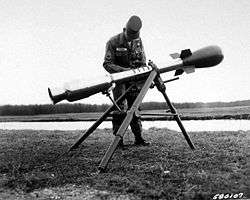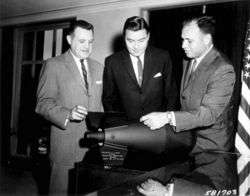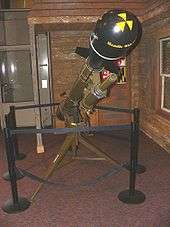Davy Crockett (nuclear device)

The M-28 or M-29 Davy Crockett Weapon System was the tactical nuclear recoilless gun (smoothbore) for firing the M-388 nuclear projectile that was deployed by the United States during the Cold War. It was one of the smallest nuclear weapon systems ever built. It is named after American soldier, congressman, and American folk hero Davy Crockett.
Development

The Davy Crockett recoilless spigot gun was developed in the late 1950s for use against Soviet and North Korean armor and troops in case war broke out in Europe or the Korean peninsula. Davy Crockett Sections were assigned to United States Army Europe and Eighth United States Army armor and mechanized and non-mechanized infantry battalions. During alerts to the Inner German border in the Fulda Gap the Davy Crocketts accompanied their battalions. All V Corps (including 3rd Armored Division) combat maneuver battalions had preassigned positions in the Fulda Gap. These were known as GDP (General Defense Plan) positions. The Davy Crockett sections were included in these defensive deployment plans. In addition to the Davy Crocketts (e.g., assigned to the 3rd Armored Division), V Corps had nuclear artillery rounds and Atomic Demolition Mines, and these were also targeted on the Fulda Gap. On the Korean peninsula, units assigned the Davy Crockett weapons primarily planned to use the passes that funneled armor as killing grounds, creating temporarily deadly radioactive zones roadblocked by destroyed tanks and other vehicles.
The M-388 round used a version of the Mk-54 warhead, a very small sub-kiloton fission device. The Mk-54 weighed about 51 lb (23 kg), with a yield equivalent to somewhere between 10 and 20 tons of TNT—very close to the minimum practical size and yield for a fission warhead. The only selectable feature with either versions of the Davy Crockett (M28 & M29) was the height-of-burst dial on the warhead. Post-Davy Crockett versions of the W54 nuclear device apparently had a selectable yield feature (see below for Hi/Lo Switch and Launching Piston references). The complete round weighed 76 lb (34.5 kg). It was 31 in. (78.7 cm) long with a diameter of 11 in. (28 cm) at its widest point; a subcaliber piston at the back of the shell was inserted into the launcher's barrel for firing.[1] The "piston" was considered a spigot prior to the discharge of the propellant cartridge in the recoilless gun chamber of the Davy Crockett. The M-388 atomic projectile was mounted on the barrel-inserted spigot via bayonet slots. Once the propellant was discharged the spigot became the launching piston for the M-388 atomic projectile. The nuclear yield is hinted at in FM 9-11: Operation and Employment of the Davy Crockett Battlefield Missile, XM-28/29 (June 1963).
The M-388 could be launched from either of two launchers known as the Davy Crockett Weapon System(s): the 4.7-inch (120 mm) M28, with a range of about 1.25 mi (2 km), or the 6.1-in (155 mm) M29, with a range of 2.5 mi (4 km). Both weapons used the same projectile, and were either mounted on a tripod launcher transported by an armored personnel carrier, or they were carried by a Jeep (M-38 & later M-151). The Jeep was equipped with an attached launcher for the M28 or the M29, as required, whereas the Davy Crockett carried by an armored personnel carrier was set up in the field on a tripod away from the carrier. The Davy Crocketts were operated by a three-man crew.[2] In the 3rd Armored Division in Germany in the 1960s many Davy Crockett Sections (all of which were in the Heavy Mortar Platoons, in Headquarters Companies of Infantry or Armor Maneuver Battalions) received what became a mix of M28 & M29 launchers [e.g., one of each per D/C section]. Eventually, the M28s were replaced by M29s, so that both the armored personnel carriers and the Jeeps carried the M29.

Both recoilless guns proved to have poor accuracy in testing, so the shell's greatest effect would have been its extreme radiation hazard. The M-388 would produce an almost instantly lethal radiation dosage (in excess of 10,000 rem, 100 Sv) within 500 feet (150 m), and a probably fatal dose (around 600 rem, 6 Sv) within a quarter mile (400 m).[3] The weapon did not have an abort function; if fired, the warhead would explode.[4]
The warhead was tested on July 7, 1962 in the Little Feller II weapons effects test shot, and again in an actual firing of the Davy Crockett from a distance of 1.7 miles (2.72 km) in the Little Feller I test shot on July 17. This was the last atmospheric test detonation at the Nevada Test Site.
Production of the Davy Crockett began in 1956, with a total of 2,100 being made. The weapon was tested between 1962 and 1968 at the Pohakuloa Training Area on Hawaiʻi island, with 714 M101 spotter rounds (not live warheads) that contained depleted uranium.[5][6] The weapon was deployed with US Army forces from 1961 to 1971. It was deactivated from US Army Europe (in West Germany) in August, 1967.[7]
Versions of the W54 warhead were also used in the Special Atomic Demolition Munition project and the AIM-26A Falcon.
- Mk-54 (Davy Crockett) – 10 or 20 ton yield, Davy Crockett Gun warhead
- Mk-54 (SADM) – variable yield 10 ton to 1 kiloton, Special Atomic Demolition Munition device
- W-54 – 250 ton yield, warhead for AIM-26 Falcon air-to-air missile
The 55th and 56th Infantry Platoons, attached to the Division Artillery of the US 82nd Airborne Division, were the last units equipped with the M-29 Davy Crockett weapons system. These two units were parachute deployed and, with a 1/2 ton truck per section, (3 per platoon) were fully air droppable. The units were deactivated in mid-1968.
Proposed German military use
One of the most fervent supporters of the Davy Crockett was West Germany's defense minister Franz Josef Strauss, in the late 1950s and early 1960s. Strauss promoted the idea of equipping German brigades with the weapon to be supplied by the US, arguing that this would allow German troops to become a much more effective factor in NATO's defense of Germany against a potential Soviet invasion. He argued that a single Davy Crockett could replace 40–50 salvos of a whole divisional artillery park – allowing the funds and troops normally needed for this artillery to be invested into further troops, or not having to be spent at all. US NATO commanders strongly opposed Strauss's ideas, as they would have made the use of tactical nuclear weapons almost mandatory in case of war, further reducing the ability of NATO to defend itself without resorting to atomic weapons.[8]
Museum examples
The following museums have a Davy Crockett casing in their collection:
- Air Force Space & Missile Museum, Cape Canaveral Air Force Station, Florida
- National Atomic Museum, Albuquerque, New Mexico
- National Infantry Museum, Fort Benning, Georgia
- United States Army Ordnance Museum, Ft. Lee, Virginia
- Watervliet Arsenal Museum, Watervliet, New York
- West Point Museum, West Point, New York
- Atomic Testing Museum, Las Vegas, Nevada
- Don F. Pratt Museum, Fort Campbell, Clarksville, Tennessee
References
- ↑ "Characteristics of all US nuclear weapons designs", USA weapons, Nuclear weapon archive, retrieved October 20, 2006.
- ↑ "Davy Crockett", Gun truck, retrieved October 20, 2006.
- ↑ "Section 5.6, Mechanisms of Damage and Injury", Nuclear Weapons (FAQ), Nuclear weapon archive, retrieved October 20, 2006.
- ↑ "Davy Crockett: King of the Atomic Frontier". www.damninteresting.com. Retrieved 2015-07-24.
- ↑ Miller, Erin (September 1, 2010). "Military says DU at PTA likely harmless: Army reports 'no likely adverse impacts' from spotting rounds". West Hawaii Today. Retrieved September 2, 2010.
- ↑ "Pohakuloa Training Area Firing Range Baseline Human Health Risk Assessment for Residual Depleted Uranium" (PDF). Cabrera Services Radiological Engineering and Remediation. Hawaii, US: Army. June 2010. Retrieved September 2, 2010.
- ↑ History of the Custody and Deployment of Nuclear Weapons(U): July 1945 through September 1977; "Prepared by Office of the Assistant to the Secretary of Defense (Atomic Energy) February 1978", Page B-7.
- ↑ "Bedingt abwehrbereit". Der Spiegel (in German) (41). DE. 1962.
Additional Reading
External links
| Wikimedia Commons has media related to M388 Davy Crockett. |
- M-29 Davy Crockett, the World’s Smallest Nuclear Weapon
- Facts about the "Davy Crockett" missile
- Loaded and unloaded M29 Davy Crockett
- Hi and Lo Height of Burst Switch
- D/C Launching Piston
- Characteristics of all US nuclear weapons designs
- DCs in 3rd Armored Division
- DCs on the highway
- President Kennedy questions Davy Crockett crewmen
- DC Souvenirs
- See John Marshall's Davy Crockett write up in the 3rd Bn, 36th Infantry section
- Davy Crocketts in Southern Avenue of Fulda Gap
- Davy Crocketts during Oct 62 Cuban Crisis (Southern Avenue of Fulda Gap)-- see especially bottom of jchorazy's Page 12
- Video showing testing of device on youtube.com
- Operation Ivy Flats — testing of the Davy Crockett, 1962 (17:46)
- Wee Gwen - a UK weapon similar to Davy Crockett